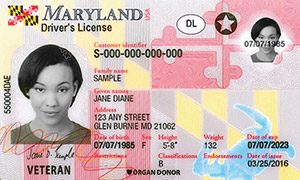- Updated for April 2025
- Based on 2025 MD commercial driver's license manual
Free Maryland CDL Permit Practice Test: General Knowledge 2025
There’s much to see and savor in the great state of Maryland. Take in the vistas of the Chesapeake Bay area and drive the Maryland Scenic Byways. There are many economic opportunities as well.
Maryland’s households are currently the wealthiest in the country, and the state’s poverty rate is the lowest in the country. The state’s economy benefits from federal government services and defense contracting because of its proximity to Washington, DC. However, nearly half of Baltimore’s residents lack access to a car and depend on public transportation. The Maryland Transit Administration (MTA) operates 80 bus lines in the Baltimore metropolitan area.
To become a commercial driver, you must obtain a Commercial Driver’s License (CDL).
There are three classes of CDLs, each designed for different types of commercial vehicles: Class A (generally for semi-trucks and tractor-trailers), Class B (generally for box trucks, dump trucks, and full-size buses), and Class C (for relatively smaller vehicles designed to carry hazardous materials or at least 16 occupants, including the driver).
Regardless of which class of CDL you plan to obtain, your first technical challenge is to pass the official General Knowledge test. This written test will evaluate your knowledge of general commercial driving theory. Once you have done so and met some other requirements, you can obtain a Commercial Learner’s Permit (CLP), which will allow you to practice commercial driving under supervision.
The official Maryland Commercial Driver License Manual contains all the information that is covered by the General Knowledge test. However, it’s designed as a reference work, not as a tutorial or textbook. You should read it, but you should also supplement your reading with better study tools.
This free Maryland CDL permit practice test is up to date as of April, 2025 and is designed to resemble the official written knowledge test in both content and structure. The 50 practice questions address such topics as cargo management, following distance, stopping distance, vehicle components, and driving under special conditions. Unlike the official test, however, you’re not under pressure to pass, and each question has both an available hint to gently lead you to the correct answer and an explanation of the correct answer. Once you’ve scored well enough on these practice tests, you can consider yourself ready to take the official knowledge test.
Test-taking tip: Be alert for keywords that either exaggerate or negate the sense of the question, such as “always,” “avoid,” “except”, “never,” or “not.” If the question says “not,” then can you find an answer choice that the driver should NOT do? Good luck!
- Perfect for first-time and renewal CDL/CLP applicants, and those adding endorsements
- Triple-checked for accuracy
What you need to know

What to expect on the actual MD MVA exam
questions
correct answers to pass
passing score
List of questions (classic view)
- Signs of distracted drivers include
- When you apply for a CDL, you will need to provide the MVA with information about the past ________ of your driving record.
- During your pre-trip test, when examining hoses with the instructor, you need to look for
- You should inspect wheel bearing seals for
- It has just reached freezing. Which of the following areas may be slippery?
- Which of the following is a key steering component?
- Where should you place your warning devices if you must stop on a one-way road or divided highway?
- According to the Maryland CDL manual, how far ahead should you look while driving?
- Which of the following are most likely to get stuck at a raised railroad crossing?
- What is the best way to figure out how many seconds of following distance you have?
- Do empty trucks have the best braking?
- If you double your speed, how much more distance will it take to stop?
- Which of the following should you NOT do if you experience a tire failure?
- Before transporting a sealed load, you must check
- What might happen if you swing wide to the left before you turn right?
- To prevent drowsiness on a trip, you should
- When backing, it is important to use a helper
- Which is NOT one of the four basic skills that operating a commercial motor vehicle requires?
- If the engine is not overheated, is it completely safe to remove the radiator cap?
- How long does it take a typical tractor-trailer to clear a double railroad track?
- If you are traveling at 55 mph in a 30-foot vehicle, you should leave how many seconds of following distance?
- If you feel drowsy while driving, what should you do?
- Which of the following is NOT true about an escape ramp?
- The minimum tread depth for front tires is
- Which of these is NOT part of the basic method for shifting up?
- Starting the engine and inspecting the cab involves each of the following tasks, EXCEPT
- What is the gross vehicle weight (GVW)?
- On wet roads, you should reduce your speed by
- If you are confronted by an aggressive driver, you should
- Letting the air out of hot tires
- In your emergency kit, you do not need to have
- Hazardous materials placards are
- When you start down a long downgrade, which of the following should influence your choice of speed?
- You should put the starter switch key into your pocket while you perform the pre-trip inspection because
- While driving at night, which lights should you use as often as you can?
- How often must you stop to check your cargo while on the road?
- An anti-lock braking system (ABS) will
- For how long will you lose your CDL driving privileges if you are convicted of a second DUI offense in either a CMV or your private vehicle?
- Total stopping distance equals
- Which of the following statements about retarders are correct?
- What is the definition of a hazard?
- In which of the following two situations should you downshift?
- The most important hand signal you should agree on with a helper is
- How many tie-downs are required for a 20-foot load?
- Why should you cover your cargo?
- Always try to back toward the driver's side because
- What is a common cause of tire fires?
- What will help a drunk sober up?
- Which of the following is NOT something you should check during a trip?
- How can you determine if your vehicle is equipped with an anti-lock braking system (ABS)?
- Alabama: Test 1 / Test 2
- Alaska: Test 1 / Test 2
- Arizona: Test 1 / Test 2
- Arkansas: Test 1 / Test 2
- California: Test 1 / Test 2
- Colorado: Test 1 / Test 2
- Connecticut: Test 1 / Test 2
- Delaware: Test 1 / Test 2
- District of Columbia: Test 1 / Test 2
- Florida: Test 1 / Test 2
- Georgia: Test 1 / Test 2
- Hawaii: Test 1 / Test 2
- Idaho: Test 1 / Test 2
- Illinois: Test 1 / Test 2
- Indiana: Test 1 / Test 2
- Iowa: Test 1 / Test 2
- Kansas: Test 1 / Test 2
- Kentucky: Test 1 / Test 2
- Louisiana: Test 1 / Test 2
- Maine: Test 1 / Test 2
- Maryland: Test 1 / Test 2
- Massachusetts: Test 1 / Test 2
- Michigan: Test 1 / Test 2
- Minnesota: Test 1 / Test 2
- Mississippi: Test 1 / Test 2
- Missouri: Test 1 / Test 2
- Montana: Test 1 / Test 2
- Nebraska: Test 1 / Test 2
- Nevada: Test 1 / Test 2
- New Hampshire: Test 1 / Test 2
- New Jersey: Test 1 / Test 2
- New Mexico: Test 1 / Test 2
- New York: Test 1 / Test 2
- North Carolina: Test 1 / Test 2
- North Dakota: Test 1 / Test 2
- Ohio: Test 1 / Test 2
- Oklahoma: Test 1 / Test 2
- Oregon: Test 1 / Test 2
- Pennsylvania: Test 1 / Test 2
- Rhode Island: Test 1 / Test 2
- South Carolina: Test 1 / Test 2
- South Dakota: Test 1 / Test 2
- Tennessee: Test 1 / Test 2
- Texas: Test 1 / Test 2
- Utah: Test 1 / Test 2
- Vermont: Test 1 / Test 2
- Virginia: Test 1 / Test 2
- Washington: Test 1 / Test 2
- West Virginia: Test 1 / Test 2
- Wisconsin: Test 1 / Test 2
- Wyoming: Test 1 / Test 2
Your go-to, trusted source
Experience the Driving-Tests differenceOur commitment to accuracy and quality in our practice tests
Explore our rigorous, multi-tiered verification process that ensures each question mirrors the official manual for unparalleled accuracy.

At Driving-Tests.org, we understand the importance of reliable and accurate practice tests to help you prepare for your DMV exam. That's why we've developed a meticulous process to create and continually update our practice questions, ensuring they reflect the most current driving laws and regulations.
Here's an inside look at how we maintain the highest quality in our practice tests.
Content Creation and Verification Process
- Alignment with Official Manuals:
Every question we develop is based on the most recent version of each state's official driving manual. Our team regularly monitors each state DMV's website for the latest updates to ensure our practice tests are always aligned with the most current information. - Community Feedback Integration:
We leverage feedback from our vast community of users to understand which topics are most frequently tested. This helps us focus on the areas that are most relevant and beneficial for your preparation. - Expert Content Creation:
Our in-house editor, Steven, who has extensive experience in driver education, crafts each question with precision. He conducts a thorough review of each question against the official manuals to ensure accuracy. - Rigorous Review Process:
Once Steven has finalized a set of questions, our team conducts a joint review session. This second level of scrutiny involves content accuracy, proofreading, and fact-checking to eliminate any errors. - User Feedback Mechanism:
After a question goes live on our site, we keep the lines of communication open. Each question features a feedback button, inviting users to report any issues or errors. This continuous feedback loop allows us to address and rectify any concerns promptly. - Responsive Updates:
In line with our commitment to accuracy, we quickly update our practice questions to reflect any changes in the DMV manuals. Additionally, we update the free electronic copy of the state's driver's license manuals on our site, typically within a few days after the DMV publishes them.
Our thorough quality control process ensures that you have access to practice tests that are as accurate and up-to-date as possible. We believe in the power of well-prepared drivers and are dedicated to providing you with the best study tools to help you succeed on your DMV exam.
Before you see your results, discover how CDL Premium helps you:
- Real CDL Exam-Like Maryland QuestionsQuestions match official CDL tests
- Official FMCSA-approvedELDT Certification included
- 99.06% Verified Pass Rate vs. 49% AverageProven success, specialized for CDL drivers



Trusted by 1.15 Million drivers
